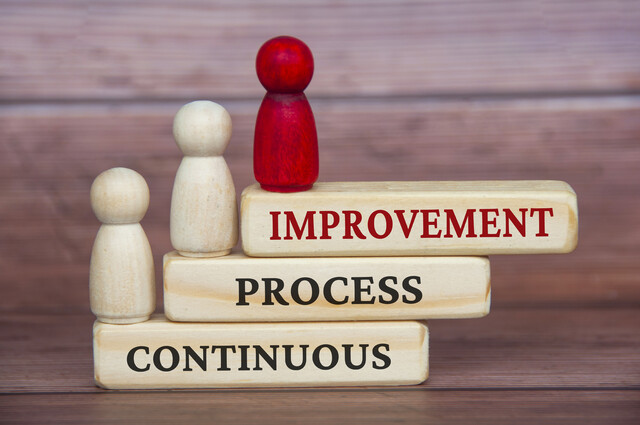There are two main objectives in this phase: define the project charter and assemble a team of Black Belts. There are many elements that go into the creation of a project charter so we will take a closer look at each of them.
Project Charters
A project charter is used to establish the scope of a project. Scope is the term used to describe the extent of involvement that the project will have on the company's operations. All projects must never deviate from their original scope, or scope creep, as we discussed in a previous chapter, will occur. The scope of the project will also clearly list the goals and initiatives and contain a schedule for deployment of the new processes or products.
The project charter will also contain the official endorsement of all stakeholders, or people who have a direct interest in the outcome of the project. These people nearly always include senior management and others who are sponsoring the project.
The charter will list all team members assigned to the project and each person will have clearly defined roles and responsibilities.
In many respects, the charter is similar to a contract. It is an agreement between the teams and the official sponsor the project. Any changes to a charter once it has been approved must go through a formal process called Requirements Change Management.
Essential Elements in a Project Charter
- A complete description of the current state of affairs in the company, incorporating both financial and operational terms. The charter should answer this question, "What is currently not operating at full or efficient capacity?"
- After the existing problems or issues are described, the charter must address what the goals of the project are. How will the problem(s) be fixed?
- The scope of the project must be defined in the charter, as discussed above.
- A list of specific deliverables should be included. Deliverables are clearly defined as are specific goals.
- A list of all stakeholders and sponsors should be included. Anyone who has a financial or other interest in the outcome of the project is a stakeholder. A sponsor is someone who is giving the official endorsement to the project.
- A list of everyone who will be working on the team(s) of the project should be included in the charter. Their roles should be clearly defined and they must understand what the sponsors expect of them.
- The official schedule of the project should be an integral part of the charter. Any deviations from the schedule (changes) must be approved during the Requirements Change Management process.
- A list of all resources required for the project, including the budget, staff costs, facilities required, supplies, outside consultants, or any other tangible resource. Staff time, even if they are salaried employees, should be considered a resource.
While the charter is a contract that should not be altered without a formal change process, it is a document that must continually be evaluated. As the project progresses, changes are inevitable and costs typically rise. Intangible costs such as project delays, staff changes, and lack of morale all constitute legitimate reasons why a project charter might need to be adjusted.
For a project to be successful every major initiative must be broken down into smaller, more manageable pieces, they must be broken down into Work Breakdown Structures. In very general terms, Work Breakdown Structures (WBS) are the exact steps necessary to complete the project. To use a simple example, if a project's main objective is to make a cup of tea, the Work Breakdown Structures may include the following: fill pot with water, turn on burner, wait until water boils, and so forth. When a company is dealing with a very complex and complicated goal, it is very helpful to have it broken down into smaller and easily obtainable steps.
Financial Overview of Project
All projects involve cost and one of the most important questions to consider before undertaking a project is to determine if the total cost of the project will be justified by the changes and improvements to be made. A project's sponsor will evaluate the finances by looking at the Financial Analysis of Benefit and Cost.
There are principally two types of costs in all businesses: fixed costs and variable costs. An example of a fixed cost is rent for a factory. If the factory produces one million toys in a month, the rent for the factory is going to be the same as it would be if it produced only a hundred toys. Depreciation is another example of a fixed cost. A piece of equipment will lose some of its value over a long period of time. The decrease in value each year is called its (annual) depreciation. Each year it will decrease the same amount so it is a fixed cost.
While the rent for the factory in the above example is a fixed cost, the fixed cost per unit will change depending on the amount produced. So, the factory that produces a million toys will have a much lower cost in rent per toy produced than the factory that produces only a hundred toys. This concept should not be confused with variable costs. Variable costs are costs that change in direct relation to the number of units sold. If a factory has a very large order and they must pay overtime to their employees, the overtime is a variable cost because it will vary depending on the number of additional hours worked. In contrast, managers who are paid a salary will get paid the same amount regardless of the time they work, so their salaries are fixed costs.
The concepts of fixed and variable costs factor prominently into determining what the total cost of the Six Sigma project will be. The amount of products produced and the amount of sales are analyzed and a breakeven point is calculated. A breakeven point is the amount where the amount of sales equals the total amount of fixed and variable costs. A breakeven point is measured in the Define Phase of the Six Sigma project so that it can be compared to the breakeven point later in the project, when process improvements have been made or products have been redesigned.
One other important concept to understand in the Define Phase is the Time Value of Money. All money held by a business has two values: a present value and a future value. If a company holds $1 million in a checking account that does not earn interest, the present value of the money is $1 million and the future value, for example, one year from today, is also $1 million. If, however, the account earns 5% interest yearly, the present value of the money is $1 million and the future value is $1,050,000. Interest totaling $50,000 would be earned over the year, so the $1 million sitting in the account currently has a future value that is $50,000 higher than its present value.
The concepts of present and future value of money are very important when defining a project's budget during the Define Phase. A company must clearly understand what its current cash position is but it must also understand what its cash reserves will be both during the project and at its completion.
The Measure Phase
This phase has four major objectives:
- The process under review (whether it is a product or a service) will be clearly defined.
- The metrics that will be used during this phase will be selected. The team will ask, "What do we want to measure?" The metrics should relate directly to the goals of the project (the deliverables).
- The team will create a baseline for all metrics. Later in the project, when the process or product has been improved, this baseline will serve as a starting point to which all subsequent data can be compared.
- The systems being used to analyze data must be verified. The data must be reliable so that the results can be both trusted and meaningful.
Many business consultants believe that the first step towards building a better business process (service or product) begins in this phase. It is crucial that a company can quantify the quality of its products in this phase. The quality cannot simply be described in written words. The quality must be expressed in terms of numbers and statistics. This will ensure that the team tracks how the quality is improved over time.
Process Definition
The first objective of the Measure Phase is to define the process being investigated. One of the most common methods of doing this is to create a flowchart.
Businesses use flowcharts to describe a process. If the business is a doctor's office, for example, a flowchart might show the exact set of circumstances that comprise a patient's visit to the doctor, including any decisions that the patient must consider and the steps that the patient must take.
Using the above example, when the patient arrives at the front desk of a doctor's office, this will be displayed in a rectangular box in the flowchart label "Patient arrives." It is a task, so it gets a rectangular box. There will be a line drawn to the next box which reads "Does the patient have a co-pay?" This box will be diamond shaped because it is a question and it requires an answer. There will be two lines drawn from the diamond box,
one labeled "Yes" and one labeled "No." Each of these lines will lead to the next step in the process. If the answer is Yes (the patient has a co-pay) the line will lead to a box that instructs the front desk to collect the payment. If the answer is No, the front desk person will follow the "No" line which leads to a task that reads "Ask the patient to please wait in the waiting room."
This example illustrates a very simple hypothetical process. In complicated Six Sigma projects, however, the flowchart will be an invaluable tool used for measuring and defining the current process being investigated. The current process must be clearly understood before it can be improved.
SIPOC Diagrams
SIPOC is an acronym for Suppliers, Inputs, Process, Outputs, and Customers. Like a flowchart, a SIPOC diagram is a map, but, in this instance, it is a high-level process map that confines its focus to specific segments of the company. In each section, the team will clearly define its suppliers, inputs, process, outputs, and customers.
- Suppliers are people or other outside companies that provide input to a process. In the example of a restaurant, a supplier might be the company that provides vegetables.
- Inputs are the material, data, or services used by the company. A restaurant's dishes, linens, and other materials are the inputs for that company.
- Process is a statement, in words only, of the precise process being studied. It can be regarded as a text version of the flowchart described above. In our restaurant example, the process might be the ordering process for a customer.
- Outputs are goals of the company, or the end results of the process. The prepared food is the output for a restaurant.
- Customers must clearly be defined, using as much demographical information as possible. The restaurant's diners, of course, are the customers. Companies should list as much information as possible about their customers in the SIPOC diagrams to get a clear understanding of their customers' needs.
Process Baseline Estimates
Establishing a baseline is very important in a Six Sigma project; it answers the question "What was the product like before we improved it?" The answer to this question must be very clearly understood, with data, not just words.
One of the reasons companies establish a baseline is to make a determination if any improvements are actually necessary. A great deal of money and effort can be spared at this point in the project when certain deliverables (goals) are eliminated from the project's scope. The original goals of the project were supported by management in the Define Phase, but sometimes the data does not support their beliefs. In a Six Sigma project, strict adherence to data must always be maintained.
A baseline also helps to determine what metrics need to be captured. If the team has observed that the quality of a product, based on survey data, has been erratic over the course of the last few years, a different strategy might be employed by the team rather than if the quality remained consistently low. For example, if the quality has remained consistently low, metrics will be chosen that will measure customers' thoughts about the product's features and reliability. But, if the quality scores have been erratic, some metrics about recent product enhancements might be chosen.
A baseline must also enable Black Belts to analyze the amount of financial value they are adding to a company. At the end of the project, they must quantify the amount of savings that they achieved. They will only be able to do this if exact cost figures are captured during the Measure Phase. Baselines provide the "evidence" necessary to prove to senior management that improvements have been made when the project is completed.
Enumerative and Analytical Studies
In the Measure Phase, the team will look at both enumerative and analytical studies, and it is important to know the difference between the two types of data collections. An enumerative study is a collection of data about a process or a product being investigated. It will contain data about its current characteristics and features. It is a study of the present time. An analytical study, however, deals with data that shows how a process is being improved over a period of time.
A Six Sigma project will use both types of data, especially for purposes of establishing a baseline. Enumerative studies will be conducted that report data about the product or service in its current state. But, throughout later portions of the Six Sigma project, analytical studies will be used to measure improvement.






























